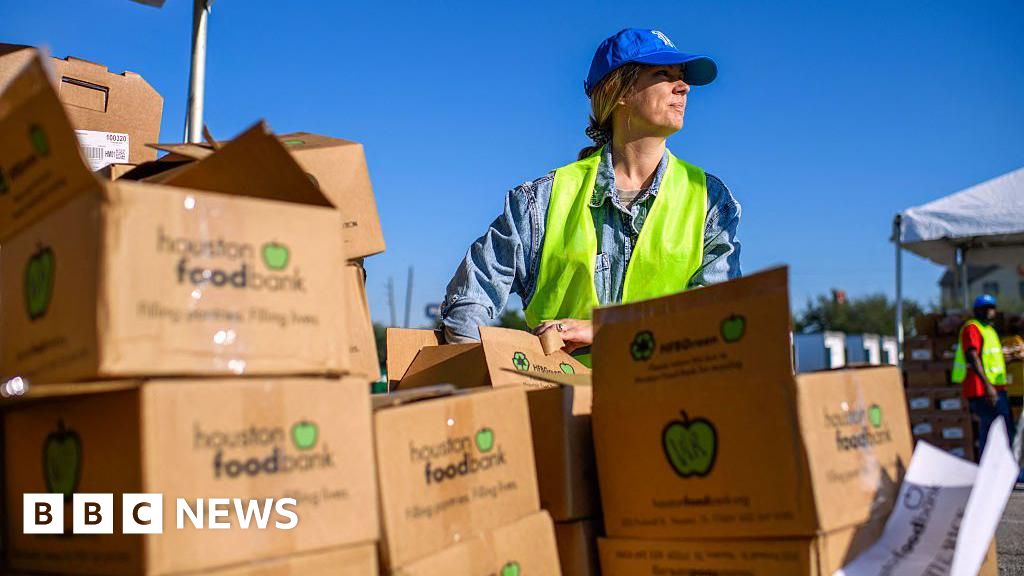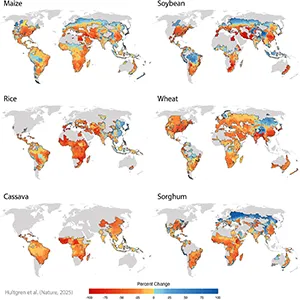Nuclear war would cripple Earth’s food supply – Earth.com

Report on the Impact of Nuclear Conflict on Global Food Security and the Sustainable Development Goals
Executive Summary
A recent study by Penn State researchers models the catastrophic impact of nuclear conflict on global agriculture, with a specific focus on corn production. The findings highlight a severe threat to global food security, directly undermining Sustainable Development Goal 2 (SDG 2: Zero Hunger). The report details the simulated scenarios, compounding environmental factors, and proposed mitigation strategies, such as “agricultural resilience kits.” The research underscores the profound fragility of the global food system and the interconnectedness of the SDGs, demonstrating how a failure in peace (SDG 16) could trigger a collapse in food systems (SDG 2), health (SDG 3), and environmental stability (SDG 13, SDG 15).
Threats to SDG 2: Zero Hunger
Projected Impacts on Global Corn Production
The study utilized the Cycles agroecosystem model to simulate the effects of atmospheric soot from nuclear firestorms on corn, the world’s most widely grown grain. The potential consequences for global food supplies are severe and directly challenge the objective of achieving Zero Hunger.
- Six Scenarios: The model assessed six nuclear war scenarios, from regional conflicts injecting 5 million tons of soot to a large-scale global war injecting 165 million tons.
- Crop Yield Collapse: The projected decline in global corn yields ranged from 7% in the best-case scenario to a catastrophic 80% in the worst-case scenario.
- Systemic Economic Impact: Researchers note that even a 7% reduction would severely impact the global food system and economy, while an 80% drop would have catastrophic consequences for human survival.
Compounding Threats to Environmental and Agricultural Stability
The direct climatic effects of a nuclear winter are compounded by secondary environmental damage, further jeopardizing food production and terrestrial ecosystems, which are central to SDG 15 (Life on Land).
- Ozone Layer Depletion: Nitrogen oxides produced by atomic explosions would damage the stratospheric ozone layer.
- Increased UV-B Radiation: The damaged ozone layer would lead to increased levels of UV-B radiation reaching the Earth’s surface, peaking 6 to 8 years post-conflict.
- Damage to Plant Life: This radiation damages plant DNA and impairs photosynthesis, placing additional stress on crops struggling to survive in lower temperatures and reduced sunlight.
- Aggravated Crop Failure: When accounting for the combined stress of climate disruption and heightened UV-B radiation, the study projects that global corn yields could fall by as much as 87%.
Proposed Interventions for Agricultural Resilience
Strategic Preparedness and Adaptation
The report proposes proactive measures to build resilience within the agricultural sector, providing a potential pathway to mitigate the worst impacts on food security and support SDG 2 in a post-catastrophe environment.
- Agricultural Resilience Kits: The core proposal is the creation and stockpiling of “agricultural resilience kits.” These kits would contain seeds tailored for different regions, with a focus on varieties that can tolerate the cold and low-light conditions of a nuclear winter.
- Adaptive Crop Switching: By switching to faster-growing and more cold-tolerant corn varieties, communities could potentially increase food yields by up to 10% compared to using standard seeds under nuclear winter conditions.
- Broad Applicability: The concept of resilience kits is presented as a valuable strategy for other large-scale disasters, such as super-volcanic eruptions, that could trigger similar climatic disruptions.
Implications for the Sustainable Development Agenda
The Interconnectedness of Global Goals
The study’s findings serve as a stark reminder of the fragility of the biosphere and the deep interdependence of the Sustainable Development Goals. The primary threat stems from a failure to uphold SDG 16 (Peace, Justice and Strong Institutions), which has cascading effects across the entire development agenda.
- SDG 2 (Zero Hunger): Directly undermined by the potential for near-total collapse of staple crop production.
- SDG 3 (Good Health and Well-being): Mass famine and malnutrition would be an inevitable consequence of global food system failure.
- SDG 13 (Climate Action): A nuclear winter represents an extreme, anthropogenic climate disruption, highlighting the sensitivity of our planet’s systems to human activity.
- SDG 15 (Life on Land): Widespread damage to plant life and ecosystems from both climate shock and UV radiation would devastate terrestrial life.
This research reinforces the understanding that global food production depends on a stable climate and functioning ecosystems. Preventing large-scale conflict is therefore a prerequisite for achieving sustainable development and ensuring the long-term viability of human and planetary health.
1. Which SDGs are addressed or connected to the issues highlighted in the article?
SDG 2: Zero Hunger
- The article’s central theme is the threat of a nuclear winter to the global food supply, specifically corn production. It discusses the potential for “catastrophic consequences” for the “global food system,” leading to widespread famine, which directly relates to the goal of ending hunger and ensuring food security.
SDG 13: Climate Action
- The article describes a “nuclear winter” as a “catastrophic climatic disruption.” It details how soot from nuclear firestorms would cause temperatures to “crash” and block sunlight, fundamentally altering the global climate. This directly connects to the goal of taking urgent action to combat climate change and its impacts.
SDG 15: Life on Land
- The research highlights the “fragility of the biosphere” and the impact on terrestrial ecosystems. It mentions that a nuclear war could shred the ozone layer, allowing harmful UV-B radiation to damage plant tissue, hurt photosynthesis, and disrupt how living things interact with the environment.
SDG 16: Peace, Justice and Strong Institutions
- The root cause of the potential catastrophe discussed in the article is “nuclear war” and “global conflict.” The entire study serves as a stark warning about the consequences of such violence, implicitly advocating for peace and the prevention of conflict, which is the core of SDG 16.
SDG 3: Good Health and Well-being
- The article states that a nuclear war “wouldn’t just kill people” directly but would also lead to mass starvation from food supply collapse. Furthermore, it discusses the threat of increased UV-B radiation, which “damages DNA,” posing a significant long-term health risk to survivors.
2. What specific targets under those SDGs can be identified based on the article’s content?
SDG 2: Zero Hunger
- Target 2.1: “By 2030, end hunger and ensure access by all people… to safe, nutritious and sufficient food all year round.” The article directly addresses a scenario where this target would catastrophically fail, with global corn yields dropping by up to 87%, leading to empty grocery store shelves and a collapse of the global food system.
- Target 2.4: “By 2030, ensure sustainable food production systems and implement resilient agricultural practices that… strengthen capacity for adaptation to climate change, extreme weather… and other disasters.” The article’s proposed solution of “agricultural resilience kits” with “cold-tolerant seeds” is a direct example of implementing resilient agricultural practices to adapt to a disaster.
SDG 13: Climate Action
- Target 13.1: “Strengthen resilience and adaptive capacity to climate-related hazards and natural disasters in all countries.” The study models the impact of a “catastrophic climatic disruption” and proposes measures like stockpiling specific seeds to build agricultural resilience and adaptive capacity for such an event.
SDG 15: Life on Land
- Target 15.5: “Take urgent and significant action to reduce the degradation of natural habitats, halt the loss of biodiversity…” The article describes how a nuclear event would degrade the atmosphere (ozone layer destruction) and harm plant life on a massive scale through climate change and UV-B radiation, representing a significant threat to biodiversity.
SDG 16: Peace, Justice and Strong Institutions
- Target 16.1: “Significantly reduce all forms of violence and related death rates everywhere.” The article’s premise is the consequence of “nuclear war,” the most extreme form of violence. By detailing the devastating secondary effects on the food supply, the study underscores the urgency of preventing such conflicts.
3. Are there any indicators mentioned or implied in the article that can be used to measure progress towards the identified targets?
For Targets 2.1 and 2.4 (Zero Hunger)
- Indicator: Global crop yields. The article uses this as a primary metric, quantifying the impact of a nuclear winter with specific figures like a “7 percent” drop in the best-case scenario and an “80 percent” to “87 percent” drop in the worst-case scenarios for corn.
- Indicator: Availability of resilient seed varieties. The proposal for “agricultural resilience kits” implies that the number and distribution of these kits, containing “cold-tolerant seeds,” would be a measurable indicator of preparedness and resilience.
For Target 13.1 (Climate Action)
- Indicator: Amount of soot in the atmosphere. The study’s models are based on this indicator, simulating scenarios with “five to 165 million tons” of soot injected into the atmosphere. This is a direct measure of the severity of the climate-altering event.
For Target 15.5 (Life on Land)
- Indicator: Level of UV-B radiation. The article identifies increased UV-B radiation as a key threat to plant life and DNA. It notes that “UV levels would peak 6 to 8 years after the bombs drop,” making it a measurable indicator of ecosystem stress.
4. Table of SDGs, Targets, and Indicators
| SDGs | Targets | Indicators |
|---|---|---|
| SDG 2: Zero Hunger | 2.1: End hunger and ensure access to sufficient food. 2.4: Ensure resilient agricultural practices and adaptation to disasters. |
– Percentage drop in global crop yields (e.g., corn yields dropping 7% to 87%). – Availability and distribution of “agricultural resilience kits” and cold-tolerant seeds. |
| SDG 13: Climate Action | 13.1: Strengthen resilience and adaptive capacity to climate-related hazards. | – Tons of soot released into the atmosphere (modeled from 5 to 165 million tons). – Degree of global temperature drop. |
| SDG 15: Life on Land | 15.5: Reduce the degradation of natural habitats and halt biodiversity loss. | – Level of surface UV-B radiation (peaking 6-8 years post-event). – Damage to plant tissue and photosynthesis rates. |
| SDG 16: Peace, Justice and Strong Institutions | 16.1: Significantly reduce all forms of violence and related death rates. | – The occurrence and scale of global conflict (the article models six nuclear war scenarios). |
| SDG 3: Good Health and Well-being | 3.9: Substantially reduce deaths and illnesses from hazardous air pollution. 3.d: Strengthen capacity for risk reduction of global health risks. |
– Deaths from famine resulting from crop failure. – DNA damage from increased UV-B radiation. |
Source: earth.com

What is Your Reaction?
 Like
0
Like
0
 Dislike
0
Dislike
0
 Love
0
Love
0
 Funny
0
Funny
0
 Angry
0
Angry
0
 Sad
0
Sad
0
 Wow
0
Wow
0











































































